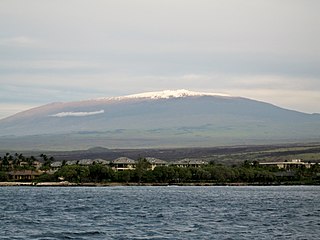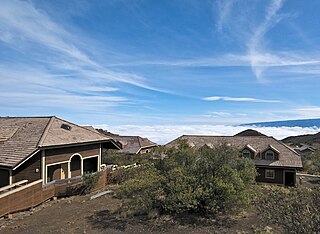
Waimea is a landlocked census-designated place (CDP) in Hawaii County, Hawaii, United States. The population was 7,028 at the 2000 census and 9,212 at the 2010 census. Since each U.S. state cannot have more than one post office of the same name, and there is a post office in Waimea, Kauai County, the official U.S. Post Office designation for Waimea is Kamuela, although this name is only used by the post office, not by locals or the local government. The name Waimea means reddish water.

In Hawaiian religion, Pele is the goddess of volcanoes and fire and the creator of the Hawaiian Islands. Often referred to as "Madame Pele" or "Tūtū Pele" as a sign of respect, she is a well-known deity within Hawaiian mythology and is notable for her contemporary presence and cultural influence as an enduring figure from ancient Hawaii. Epithets of the goddess include Pele-honua-mea and Ka wahine ʻai honua.

Mauna Kea is an inactive shield volcano on the island of Hawaiʻi. Its peak is 4,207.3 m (13,803 ft) above sea level, making it the highest point in Hawaii and second-highest peak of an island on Earth. The peak is about 38 m (125 ft) higher than Mauna Loa, its more massive neighbor. Mauna Kea is unusually topographically prominent for its height: its wet prominence is fifteenth in the world among mountains, at 4,205 m (13,796 ft); its dry prominence is 9,330 m (30,610 ft). This dry prominence is greater than Mount Everest's height above sea level of 8,848.86 m (29,032 ft), and some authorities have labeled Mauna Kea the tallest mountain in the world, from its underwater base. Mauna Kea is ranked 8th by topographic isolation.

The Mauna Kea Observatories (MKO) are a group of independent astronomical research facilities and large telescope observatories that are located at the summit of Mauna Kea on the Big Island of Hawaiʻi, United States. The facilities are located in a 525-acre (212 ha) special land use zone known as the "Astronomy Precinct", which is located within the 11,228-acre (4,544 ha) Mauna Kea Science Reserve. The Astronomy Precinct was established in 1967 and is located on land protected by the Historical Preservation Act for its significance to Hawaiian culture. The presence and continued construction of telescopes is highly controversial due to Mauna Kea's centrality in native Hawaiian religion and culture, as well as for a variety of environmental reasons.

Kawainui Marsh or Kawainui Fishpond is a wetland and former fishpond in Kailua, Hawaiʻi. It is the largest remaining wetland and the largest ancient freshwater fishpond in Hawaiʻi, and a designated Ramsar Convention wetland.

Kapa is a fabric made by native Hawaiians from the bast fibres of certain species of trees and shrubs in the orders Rosales and Malvales. The bark is beaten and felted to achieve a soft texture and dye stamped in geometric patterns.

Hāmākua is a district on the northeast coast of Hawaiʻi's Big Island, administered by the County of Hawaiʻi in the state of Hawaiʻi. It is also the name given for the coastline in the region, the "Hāmākua Coast".

The Onizuka Center for International Astronomy, also known as Hale Pōhaku, is a complex of support facilities for the telescopes and other instruments that comprise the Mauna Kea Observatory atop Mauna Kea, on Hawaiʻi island.

The Mauna Kea Ice Age Natural Area Reserve is a Hawaii state natural reserve that includes the Mauna Kea Adz Quarry, on the southern slope of Mauna Kea on the island of the Hawaiʻi.

The Thirty Meter Telescope (TMT) protests are a series of protests and demonstrations that began on the Island of Hawaii over the choosing of Mauna Kea for the site location of the Thirty Meter Telescope. Mauna Kea is the most sacred dormant volcano of Native Hawaiian religion and culture, and was known to natives as the home to Wākea, the sky god. Protests began locally within the state of Hawaii on October 7, 2014 but went global within weeks of the April 2, 2015 arrest of 31 people who had blockaded the roadway to keep construction crews off the summit.

Kapaemahu refers to four stones on Waikīkī Beach that were placed there as tribute to four legendary mahu who brought the healing arts from Tahiti to Hawaiʻi centuries ago. It is also the name of the leader of the healers, who according to tradition, transferred their spiritual power to the stones before they vanished. The stones are currently located inside a City and County of Honolulu monument in Honolulu at the western end of Kuhio Beach Park, close to their original home in the section of Waikiki known as Ulukou. Kapaemahu is considered significant as a cultural monument in Waikiki, an example of sacred stones in Hawaiʻi, an insight into indigenous understandings of gender and healing and the subject of an animated film and documentary film.
Bernice A. Akamine is an American artist and Hawaiian rights activist. Her visual art has taken multiple forms, including glass and feathers, and she teaches traditional Hawaiian art techniques such as the creation of kapa cloth and natural dyeing using Hawaiian plants. Akamine is an advocate for Indigenous land rights, using her artwork to bring attention to the colonial invasion of Hawaii and its continued effects on the native Hawaiian population.
Dalani Tanahy is an American artist specializing in the Hawaiian art of creating kapa, fabric made by beating bark. Tanahy creates kapa for artistic and ceremonial purposes and teaches courses and workshops. She is the founder of Kapa Hawaii, an organization dedicated to reviving and preserving the art of kapa creation.

Greta Mae "Puanani" Kanemura Van Dorpe (1933–2014) was an American artist and master of kapa, the Hawaiian art of making cloth from bark fibers. Van Dorpe spent more than forty years researching the forgotten craft of making kapa, investigating the tools and materials used by ancient Hawaiians and experimenting to replicate the cloth. She has been credited as one of the women responsible for reviving the art of kapa in the 1970s.
Mary "Aunty Malia" Blanchard Solomon was an American textile artist and expert on Hawaiian customs, crafts, and culture. Solomon researched and traveled across the South Pacific to regain lost knowledge about kapa, the traditional Hawaiian craft of making cloth from the fibers of trees. The Chicago Tribune called Solomon one of Hawaii's "foremost amateur anthropologist/historians."
Ka Wai Ola is a Hawaii-based newspaper published by the Office of Hawaiian Affairs.
Jamaica Heolimeleikalani Osorio is a Kanaka Maoli poet, educator, and activist who lives and works in Hawai'i. She is known for her poetry and activism centered on Hawaiian culture and identity.
Jonathan Kamakawiwoʻole Osorio is a Native Hawaiian professor of Hawaiian studies. He is the Dean of the Hawaiʻinuiākea School of Hawaiian Knowledge at the University of Hawaiʻi at Mānoa.
Haunani Kahalewai was a singer and entertainer known as the "First Lady of Song in Hawai‘i". Her distinctive contralto voice spanned three octaves. She was featured on dozens of recordings and headlined the Polynesian Review at the Royal Hawaiian Hotel in Waikiki. Kahalewai was inducted into the Hawaiian Music Hall of Fame in 1996.
Kamana Beamer is an author, geographer, and educator on natural resources and Hawaiian Studies. He currently holds the Dana Naone Hall Chair in the Center for Hawaiian Studies with a joint appointment in the Richardson School of Law and the Hawai‘inuiākea School of Hawaiian Knowledge at the University of Hawai'i at Mānoa. He is one of eight panelists appointed by Hawai'i Governor David Ige to hold stewardship over Mauna Kea.












